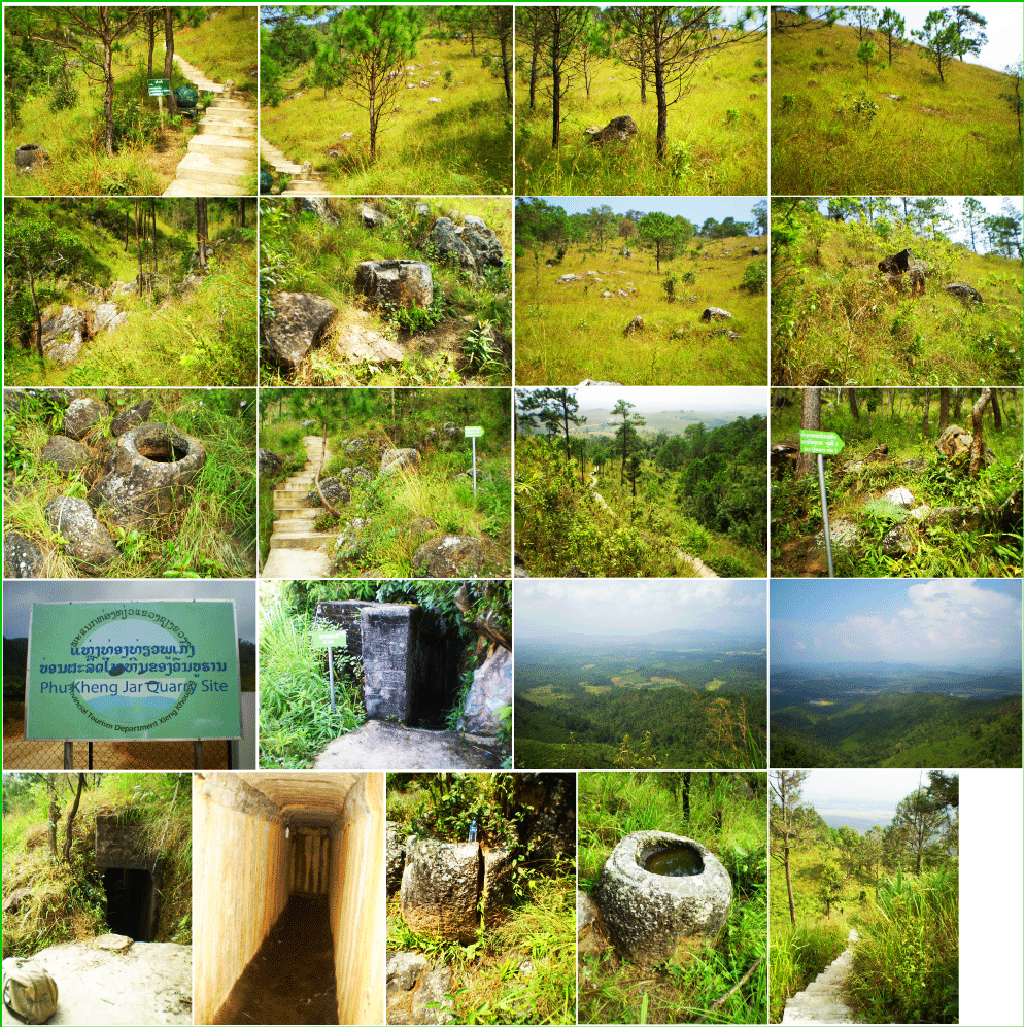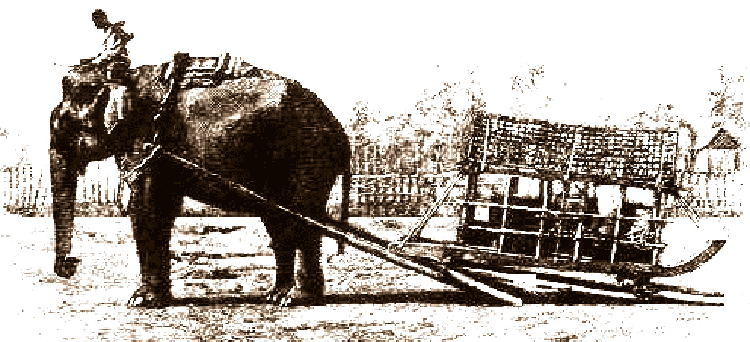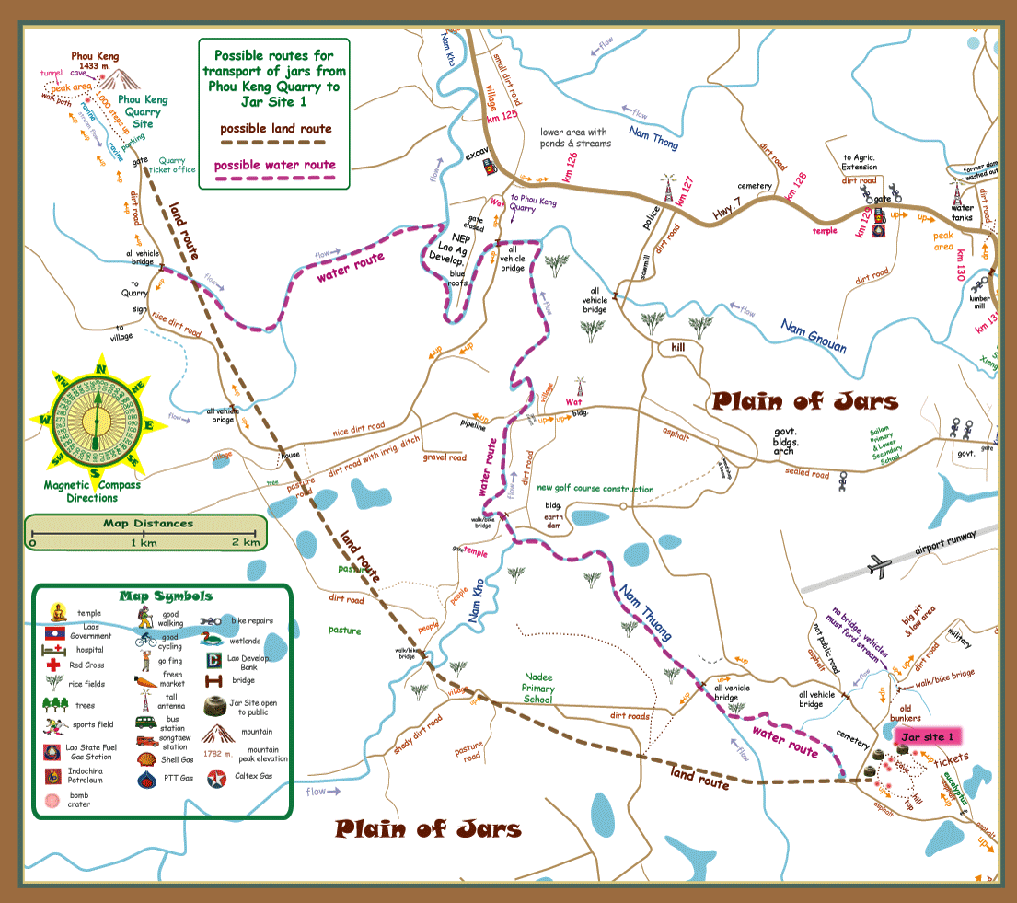
Jar Quarry Site on Phou Keng mountain at Plain of Jars, Laos - HoboMaps.com- Go to Plain of Jars Info Page - - - Home
The jar quarry site at Phou Keng mountain about 15 km northwest of Phonsavanh town was opened for visitors in early 2012. It is located at grid code JN165 on this map HERE which also shows the road and route for driving to the site from Phonsavanh or from Highway 7.
On our visit to the quarry site we only saw a steep ravine with boulders lying about, some of which have been partially carved into jars. We didn't see any place where blocks of stone had been removed or extracted from a larger mass of stone as one might expect when thinking of a typical "quarry".
Although the hours for visitation were not posted we expect them to be the same as the Jar Sites which are roughly open from 08:00 to 17:00 daily with some seasonal variation. A guide is not needed or required as there is a single set of over 1,000 concrete steps leading up a steep ravine to the summit where you find a secret tunnel and a natural cave plus views out over the surrounding area. These steps can be quite tiring to climb and you need to be in good physical condition to get to the summit. Coming down is also tiring and a strain on already tired leg muscles so best to have much time and take many breaks.
Partially-carved jars lie on both sides of the concrete steps for easy viewing. Pictures taken at the quarry in October 2012 are shown below.

Transport of Jars from Phou Keng Quarry
Government officials have declared that the jars from the Phou Keng Quarry site were transported to Jar Site 1 on the Plain of Jars about 9 or 10 kilometers away.
It seems possible the transport journey on the mostly flat terrain from the base of the mountain to Jar Site 1 could have been done since there are no major natural obstructions on the way other than 2 rivers and 2 streams. If the transporters were required to transfer the jars to some sort of raft or barge for these river crossings we might imagine they would try to continue the transport trip as far as possible on the river and maybe even get almost to Jar Site 1 on connected waterways, including man-made ones such as irrigation canals. Such water transport might be best near the end of the rainy season when water levels are high and we can imagine jar transport as an annual affair with jars being carved throughout the year at the quarry site with the transport of many jars occurring once a year as an annual event.
The first part of a jar transport trip would be sliding the jars down the steep ravine at the quarry. None of the partially-carved jars seen at the quarry site seem too large to be transported down the hill on some sort of sled pulled by an elephant such as the one shown below or by a team of buffalo, oxen or bullocks.

In Oct. 2012 we measured the largest jars found at the lower level of Jar Site 1 which contains well over 100 jars and have estimated the largest to weigh about 1,830 kilograms or 4,030 pounds. However, at least 10 jars at the upper level of Jar Site 1 are bigger than this one including the King Jar whose estimated transport weight is 9,100 kilograms or 20,000 pounds which may have been too large for transport and may have been carved from a naturally-situated boulder at the jar site.
The map below shows there are possible routes from Phou Keng Quarry to Jar Site 1

Water Transport of Jars
We might wonder if some of the jars would have been too heavy for water craft transport long ago but it seems this would not have been a problem in the 1880s as reported by James McCarthy in his excellent publication Surveying and Exploring in Siam. If people back then could transport 3 elephants at one time on a hastily-constructed raft over a big river it seems possible a single jar which would weigh much less could have been transported on or over smaller rivers in earlier times.
McCarthy quote from page 39 - "It was interesting to observe the behaviour of the elephants when they were being sent across the river. Some swam over quietly enough; some, after making an emphatic protest, gave way; but there were others that could not be impelled, even by goading with spars or by the application of fire - they rushed back, and nothing could force them over. For these the men had recourse to another process. Having lashed together three ordinary dug-outs, they laid spars across them, about 4 feet long and 3 inches in breadth and thickness, and on these placed a flooring of 1-inch planks, covering the whole with plantain stalks and other fodder. I was doubtfully considering whether this extemporized raft was strong enough to bear even one elephant when, to my surprise, three walked on board and were safely carried to the other side."
If we were to try to re-enact such a water transport route today the routes depicted on the map above might be possible and would get the jars to about 500 meters from the lower level of Jar Site 1. If a land transport route were followed with only 2 river crossings to deal with the transporters might have constructed a temporary bridge or chosen a time of year when river levels were lowest at the end of the dry season when there were shallow crossings.